The 10 moments that made the midterms

From the Women’s March to the Kavanaugh confirmation drama, here are the events that have shaped the 2018 midterm elections — and how they will reverberate in key races on election night.
Jan. 21, 2017: The Women’s March
The day of Trump’s inauguration may have set the stage for his party’s midterm meltdown nearly two years later.
It started with a Facebook event — a woman in Hawaii, the morning after Election Day, inviting friends to protest Trump’s victory by marching on Washington, D.C. Other women created similar events. Soon they joined forces. Partners like Planned Parenthood came on board. Pussy hats were sewn, signs were made, flights were booked. And on Jan. 21, approximately 500,000 marchers descended on the nation’s capital — about three times the number of people in town for Trump’s inauguration.
The worldwide estimates were just as dizzying: 673 separate Women’s Marches on all seven continents, with as many as 7 million participants.

“Watched protests yesterday but was under the impression that we just had an election!” Trump tweeted. “Why didn’t these people vote?”
The president lost the popular vote by nearly 3 million ballots, so many of “these people” may have, in fact, voted. But he did have a point. The big question on Jan. 22 — and beyond — was whether the march could become a movement, and whether that movement could influence our politics. Twenty-two months later, the first answer, at least, is clear.
Amid the backdrop of the broader #MeToo movement, more women launched campaigns this cycle for the U.S Senate (53), U.S. House (476), governor’s mansion (61) and state legislature (3,388) than ever before. Many were first-time candidates. Activism among women — especially college-educated suburban women — skyrocketed as well.
The polls reflected this political reckoning. Trump’s approval rating among women — roughly 30 percent approve to 60 percent disapprove — had long been significantly lower than his overall rating. In time that translated into a commensurate split in congressional party preference, with Democrats leading among women voters by the same 60-30 margin — the largest gender gap since 1958, according to CNN.
White women in particular peeled away from the president, whom they had supported by a few points in 2016; now they were telling pollsters they backed Democrats by 10 to 15 points. For the most part, the group driving this shift was white women with college degrees.
The problem for Republicans is that roughly 30 of their most vulnerable 2018 congressional seats — more, it’s worth noting, than the 23 Democrats need to flip the House — are located in precisely the sort of upscale suburbs where these educated white women tend to cluster.
– Andrew Romano
May 9, 2017: Trump fires Comey, Mueller starts investigating
Some form of forcible removal has hung over Donald Trump for most of his presidency. Conservative columnist Ross Douthat floated the prospect of using the 25th Amendment – which says the president can be removed if deemed “unable” to do the job — in May of 2017.
“The presidency now has kinglike qualities, and we have a child upon the throne,” Douthat wrote.

Douthat wrote that column a week after Trump fired FBI Director James Comey. Comey’s zig-zag path during the 2016 election had put Trump’s own arbitrary sense of right and wrong on display. When Comey recommended in July 2016 that the Justice Department not bring charges against Hillary Clinton for her use of a private email server while secretary of state, Trump was outraged. When Comey announced that the FBI had reopened their investigation into Clinton’s emails just a week before the election, violating normal protocols for handling that type of information, Trump praised him.
But Trump’s relationship with Comey permantently soured after the FBI director briefed him on the infamous Steele dossier on Jan. 5, two weeks before his inauguration. Comey knew that Trump might think he was “dangling the prostitute thing over him to jam him, to gain leverage … pulling a J. Edgar Hoover,” as Comey wrote in his book, “A Higher Loyalty.”
Trump said he’d fired Comey in part because of the FBI’s investigation into his campaign’s possible collusion with Russian agents. Comey said Trump had asked him to drop the FBI probe of of Michael Flynn, his first national security adviser. And talk of impeachment went into overdrive. Even a few Republican members of Congress in heavy Democratic districts began to talk about it.
The ongoing investigation by special counsel Robert Mueller kept the prospect of impeachment on the table. Then, as the midterm elections approached, the impeachment conversation entered a new phase.
Republican operatives tried to ring the alarm over the summer hoping to motivate a lackadaisical conservative base. But Trump was content to talk instead about how he thought polling was wrong in 2016 (it wasn’t), and how it would be wrong again in 2018. Instead of a “blue wave” of Democratic wins, Trump predicted a “red wave” of Republican wins in Congressional elections, and his followers believed him. By the end of the summer, however, top Trump advisers finally got him to stop deluding himself and his acolytes about the fall elections, and to warn of possible impeachment if Democrats took the House.

On the Democratic side, there was a push by some, like billionaire Tom Steyer, to have the party campaign on impeachment. Steyer poured $50 million into this effort. But more experienced party leaders like House Minority Leader Nancy Pelosi, D-Calif., have successfully deflected the issue. And currently, not even progressive groups like Justice Democrats want to talk about impeachment.
When Republican Wendy Rogers ran a TV ad telling Arizona voters that if they reelected Democratic Rep. Tom O’Halleran it would result in impeachment, O’Halleran nonchalantly told NBC News, “There is only one candidate in this race who is talking about impeaching the president, and it is not me.”
– Jon Ward
July 28, 2017: McCain’s “no” vote on Obamacare
John McCain may have done more to shape this year’s midterms than anyone not named Donald Trump.
The Affordable Care Act became the law of the land in March 2010, extending insurance to more than 20 million Americans. The GOP spent the next six-plus years campaigning against it — on the trail, in the courts and in Congress itself.
But a funny thing happened once the GOP gained power and Americans began to grapple with the real-life consequences of repeal — namely, the elimination of popular protections for people with preexisting conditions. Polls started to show that more voters viewed the law as a good idea than a bad one.
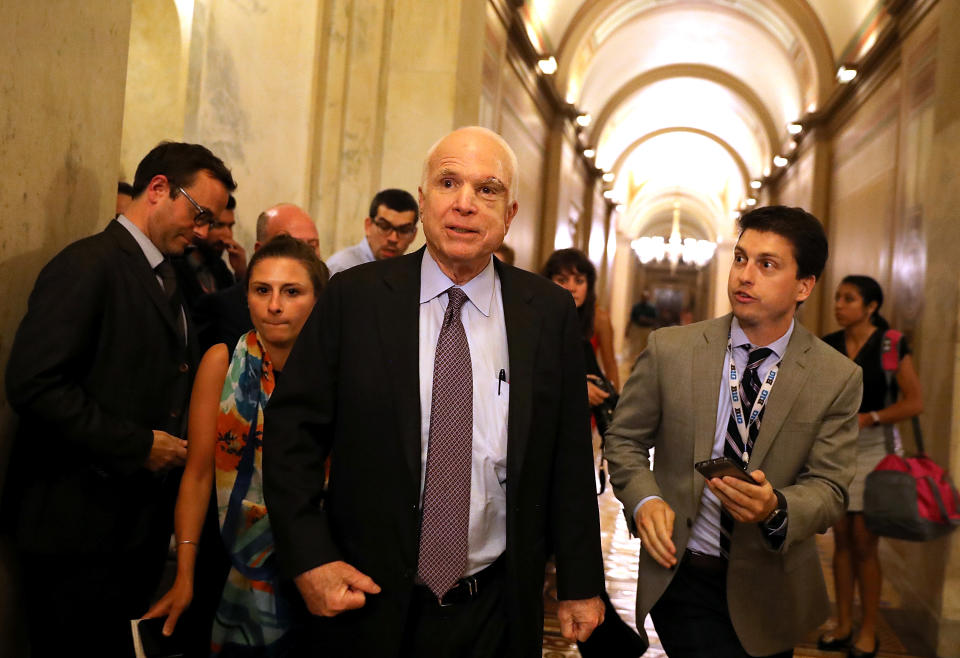
Still, the GOP barreled ahead. Trump undermined Obamacare’s insurance exchanges via executive order, while congressional Republicans devoted the entire first half of 2017 to passing their long-promised repeal-and-replace legislation.
Enter McCain. The Arizona senator had never been a fan of Obamacare. But there was something he hated even more than his 2008 rival’s signature health law: the closed-door, rushed process that had produced his own party’s repeal plans.
“Wait for the show,” he told reporters as he walked into the Senate for his party’s last-ditch repeal vote. And when his turn came to weigh in, McCain turned his thumb down.
Repeal was dead. The immediate hot takes suggested that the problem for Republicans was that the base would stay home in 2018, but that ended up being a false alarm. The real problem was that 217 House Republicans had just voted to axe Obamacare and either end or weaken its most popular provisions — and now they were left with no alternative vision to sell to voters before Election Day.
Democrats seized on this vulnerability; nearly every media market has been deluged with ads declaring that the local Republican incumbent wants to take away protections for people with preexisting conditions, and nearly every Democratic challenger has been repeating the same line on the stump.
In Arizona, GOP Rep. Martha McSally, who is competing against Democratic Rep. Krysten Sinema for the Senate seat of retiring Republican Jeff Flake, recently admitted that the attacks are having an effect. “Well, Sean, I did vote to repeal and replace Obamacare on that House bill,” McSally told Sean Hannity last week. “And I’m getting my ass kicked for it right now.”
– Andrew Romano
Oct. 1, 2017 to Feb. 14, 2018: Back-to-back mass shootings
Three of the 10 worst mass shootings in American history took place a year ago, all in a few short months. On Oct. 1, 2017, a 64-year old real estate investor fired over 1,000 rounds into a concert crowd on the Las Vegas strip from the 32nd floor of an overlooking hotel. He killed 58 people and then himself. It was the most killed in a mass shooting in the nation’s history, and a staggering 851 people were injured. Just over a month later, a 26-year old male shot and killed 26 people, injuring 20 others, inside a small church building in Sutherland Springs, Texas.

On Feb. 14 of this year, a former student from Marjory Stoneman Douglas High School in Parkland, Fla., shot and killed 14 students and three adult staff, injuring 17 others. It was the worst school shooting in American history. In May, a high school student in Santa Fe, N.M., shot and killed 10 people at the beginning of the school day, wounding 13 others.
After Vegas, Sutherland Springs, Parkland — and now most recently the slaughter of 11 congregants at a Pittsburgh synagogue on October 28 — the politics of gun control has shifted. More voters now support some form of stricter gun control, especially universal background checks and taking steps to prevent the sale of firearms to the mentally ill.
And for the first time in 20 years, gun control groups are on pace to outspend the National Rifle Association and other organizations who oppose most forms of gun control, according to a Reuters report. Though final spending figures could narrow the gap, as of the final reporting period before the election, gun control groups had spent $20 million compared to just $14 million for antigun control groups. By comparison, the NRA spent $54 million in the last nonpresidential election in 2014.

Ads on gun control, for and against, have made up one out of every 10 campaign ad on TV this year, compared to just 3 percent of all ads four years ago, a Wall Street Journal study found. And 60 percent of all gun-focused ads this year have been in favor of some form of gun control.
– Jon Ward
Dec. 12, 2017: Roy Moore loses in Alabama, Bannon out of White House
Steve Bannon planned to play a kingmaker role in the 2018 midterm elections. His access to major donor money and his perch at Breitbart gave him two points of leverage with which to wage war inside the Republican Party against the Washington establishment symbolized by Senate Majority Leader Mitch McConnell.
His candidates: Kelli Ward in Arizona. Chris McDaniel in Mississippi. Kevin Nicholson in Wisconsin. Corey Stewart in Virginia. Erik Prince in Wyoming. Danny Tarkanian in Nevada.
All of these were hard-right candidates lining up to dismantle the establishment wing of the Republican Party even more than it already has been under Trump. And for a while, it looked like it might work, throwing Republican hopes of keeping control of the Senate into total chaos.
Roy Moore was going to be a training exercise, a dry run for the Bannon machine. It was going to be a layup to get the former Alabama Supreme Court Chief Justice, a Christian fundamentalist, elected to the U.S. Senate to replace Attorney General Jeff Sessions. When Bannon endorsed Moore at the end of August 2017, Moore was leading his Republican opponent in almost every poll.
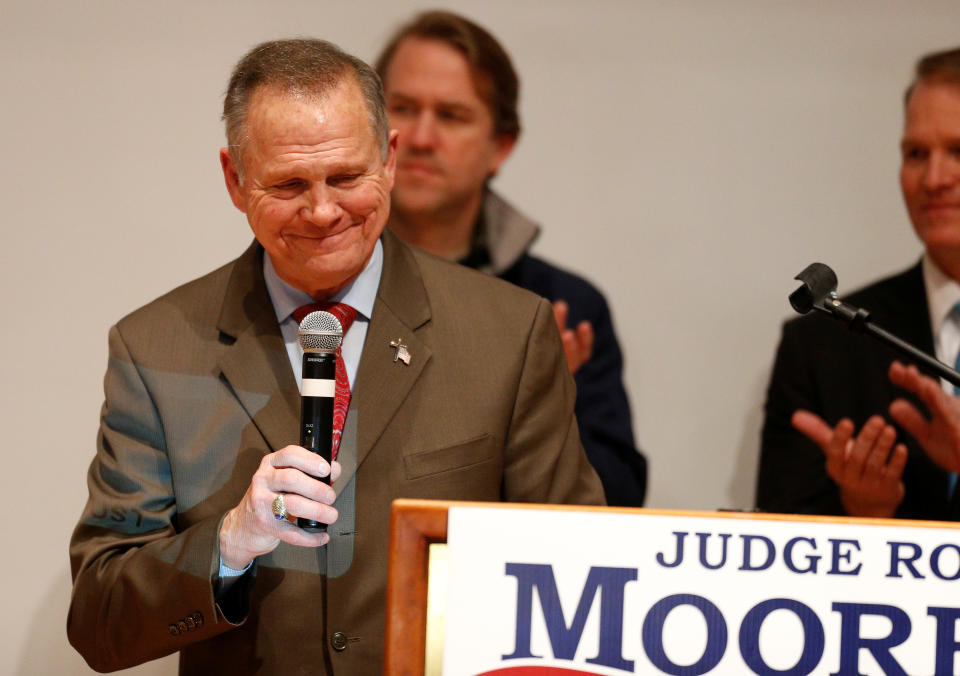
When Moore won the primary on Sept. 25, 2017, Bannon was exultant and spoke of starting “a revolution.” Sen. Bob Corker, R-Tenn., another moderate, had announced his retirement that same day, opening up another seat for an insurgent candidate. “You are going to see, in state after state after state, people that follow the model of Judge Moore,” Bannon crowed.
A month after Moore’s primary win, Sen. Jeff Flake, R-Ariz., announced his retirement, opening the way for Ward.
“Nobody’s safe. We are coming after all of them and we’re gonna win,” Bannon said on Fox News.
But two weeks after the Flake news, the Washington Post first reported allegations from one woman who said a 32-year-old Moore had molested her 40 years prior, when she was 14, and from two other women who said he had taken them on dates and kissed them when they were underage teenagers.
More women came forward to say Moore had assaulted them or acted inappropriately. Democrat Doug Jones won the Dec. 12 special election, making Moore the first Republican to lose a Senate election in 26 years. Trump and his allies were embarrassed and enraged, and with some help from McConnell allies, blamed Bannon.
Then a month later, Michael Wolff’s book “Fire and Fury” was released. Bannon was quoted blasting Trump and his son Don Jr. That admission severed his relationship with the president and with the Mercers, who ousted him from Breitbart.
Meanwhile, Bannon’s other candidates fared no better. Ward and Nicholson lost in Republican primaries to more established candidates. Tarkanian dropped out at Trump’s urging. Prince declined to run. And Stewart and McDaniel, both cheerleaders for the Confederate flag, have failed to gain any traction.
– Jon Ward
Dec. 22, 2017: Trump delivers a tax cut
President Trump signed the Republican-passed tax cuts three days before Christmas last year, proclaiming it “the largest tax [cut] in our history” and “the biggest reform of all time.”

That wasn’t true. It was “the eighth largest … even smaller than two of Barack Obama’s tax cuts,” according to Washington Post reporter Glen Kessler. But Trump repeated that claim dozens of times during his first year in office.
Trump made lots of other pledges that day he signed the tax bill, which lowered the corporate tax rate to 21 percent from 35 percent, lowered individual tax brackets as well, and doubled the standard deduction. The corporate rate reduction was permanent, but the individual rate decreases expire in 2025.
He predicted that Democrats would suffer politically for not supporting it. Not one Democrat in Congress voted for the bill. “The Democrats already regret it. You know, they have their typical thing — ‘It’s for the rich.’ They know that’s not true,” Trump said. And he said he doubted Republicans would have to persuade Americans that the legislation was a good idea. “It’s selling itself,” he said. “I don’t think we’re going to have to do much selling.”
Republicans, however, spent millions of dollars on ad campaigns to promote the bill. And still, the tax cut has been a political flop.
Twice as many Americans told a Republican polling firm commissioned by the Republican National Committee that the bill advantaged “large corporations and rich Americans” rather than “middle class families,” in a survey completed Sept. 2 and obtained by Bloomberg News.
And that view was not without merit. “By 2027, after the individual changes have sunset, 83 percent of the benefits will go to the top 1 percent,” Sahil Kapur and Joshua Green of Bloomberg wrote.
The numbers are better when it comes to approval for the tax cuts: 44 percent approved it and 45 percent didn’t. But the pollsters concluded that Republicans had “lost the messaging battle.”
– Jon Ward
March 13, 2018: Conor Lamb wins in a deep-red district
In previous cycles, Democrats had failed to field challengers in tons of politically promising districts, conceding hundreds of seats up and down the ballot to uncontested GOP incumbents. But 2017 and 2018 attracted droves of diverse, often rookie candidates appalled by President Trump and itching to “resist.”
Conor Lamb was their first poster boy.

In early 2018, a special election was held in Pennsylvania’s 18th Congressional District, south of Pittsburgh. The Republican candidate was state Rep. Rick Saccone; the Democratic candidate was Lamb, an assistant U.S. attorney. And even though the largely white, predominantly blue-collar district had just voted for Trump by 20 percentage points, Lamb narrowly won, becoming the area’s first Democratic congressman in 15 years.
Like many House incumbents, Murphy had run unopposed in several prior elections. What Lamb proved is that Democrats can succeed in places their party had previously written off.
Provided, of course, that they show up.
And show up they have. By Dec. 31, 2017, more than 2,100 people had filed paperwork to run for the House or Senate, the most since the Federal Election Commission started keeping track in 1977. At that point, 510 Democratic House challengers had raised $50,000 or more, just shy of the GOP’s record-setting total (522) from 2010 — the year Republicans wound up flipping 63 seats and retaking control. And when primary season came to a close, it became clear that Democrats were actually better-positioned to pick off incumbents than Republicans had been eight years earlier. In 2010, for instance, 22 Democratic incumbents drew no GOP challenger. In 2018, however, Democratic candidates were challenging all but 10 Republican representatives — an unprecedented feat.
The stats were even more striking on the state level. For the past six election cycles, Republicans fielded more state-legislative candidates than Democrats. But this cycle, Democrats fielded more of these candidates (5,349 as of September) than either party has produced over the past two decades, and more than Democrats have run since 1982; overall, only 27 percent of state-legislative seats are uncontested this year, the lowest rate in nearly half a century.
But it’s not just quantity; quality matters as well. Stacey Abrams, the Democratic gubernatorial nominee in Georgia, has garnered a lot of attention for her historic bid to expand her red state’s electorate become America’s first black female governor. Yet Democratic candidates are unusually competitive in other, redder states as well; Laura Kelly narrowly leads Republican Kris Koback in Kansas, and Drew Edmonson is gaining ground in Oklahoma, of all places.
Pay attention to those contests to see how much recruitment matters on Election Night. Pay attention to state legislative races too — especially in Colorado, Minnesota, New York, Maine, Wisconsin, New Hampshire, Arizona, Florida, and Michigan, where Democrats could flip one or both chambers.
Watch the entire House battleground, of course, but pay particular attention to California, where so many Democrats signed up to run in the seven GOP-held districts won by Hillary Clinton that party officials once worried they’d split the vote and fail to advance through the state’s nonpartisan, top-two primary system.
Ultimately, Democrats dodged this bullet, and now they have strong challengers running even with Republican incumbents such as Dana Rohrabacher and Mimi Walters in districts where previously the party had only managed to field underfunded sacrificial lambs. That change — the decision to show up and compete this time around — could change who controls Congress.
– Andrew Romano
May 7, 2018: Sessions announces ‘family separation’ policy
In early May, Attorney General Jeff Sessions publicly declared that “if you cross the border unlawfully … then we will prosecute you. If you don’t want your child separated, then don’t bring them across the border illegally. It’s not our fault that somebody does that.”
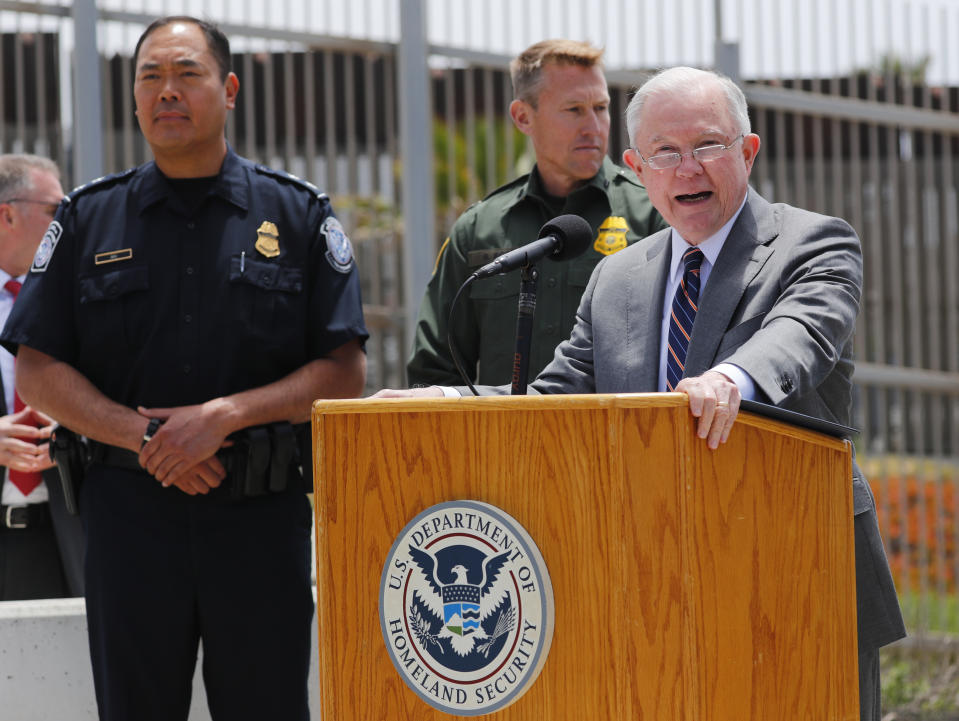
Thus began one of the most contentious political seasons in recent memory. Over the following six weeks, the administration kept its word, enforcing its “zero-tolerance” border policy — and seeking to deter further migration — by separating nearly 3,000 children from their parents.
As footage of sobbing minors confined to cage-like pens spread through the media, public outrage mounted. Protests ensued, as did harsh condemnations from international human rights organizations.
Finally, on June 20, Trump reluctantly signed an executive order ending family separations at the border. Two months later, 528 children — about a fifth of the original total — had still not been reunited with their parents.
Latinos were hardly the only Americans upset by the administration’s actions. But as the community most directly affected by family separation, their response would be one way to measure the political repercussions for Trump’s GOP.
For months, pundits had speculated about whether the notoriously low-turnout group, which traditionally votes Democratic, would “show up” in 2018. Everyone agreed that their impact could be enormous; of the 23 Republican-held House districts that Hillary Clinton carried two years ago, 11 have populations that are at least 20 percent Latino — enough, in theory, to push Democrats across the finish line.
So would family separation — among Trump’s other immigration-related provocations as president — finally convince Latinos to turn out where it matters most on Election Day?
The early evidence, as we reported late last month, suggests the answer may be yes.
Consider California, where most of those 11 heavily Latino, pro-Clinton, GOP-held districts are located. According to early vote totals compiled by Political Data, Latino turnout in Southern California’s most competitive House contests is already far outpacing 2014 — even equaling 2016’s presidential-year turnout in some cases.
It’s unlikely that Trump’s GOP will benefit from this upswing. According to a new NALEO Educational Fund/Latino Decisions tracking poll, 72 percent of Latinos say they have an unfavorable opinion of Trump, and 73 percent of likely Latino voters say they plan to vote for Democrats this year.
– Andrew Romano
June 26, 2018: Alexandria Ocasio-Cortez wins the NY-14 primary,
Bernie Sanders was the warning shot. Is Alexandria Ocasio-Cortez the wave of the future?
The educator, activist and former bartender was a total unknown when she entered the Democratic primary for her Bronx-based congressional district; her entire political résumé consisted of working as an organizer for the Sanders presidential campaign.

Yet on June 26 she somehow succeeded in doing what Sanders himself failed to do in 2016: She defeated a powerful, centrist frontrunner (in this case, Democratic Caucus Chair Joe Crowley) while running as an unapologetic Democratic Socialist.
“The most significant loss for a Democratic incumbent in more than a decade,” declared the New York Times, “and one that will reverberate across the party and the country.”
Reverberate it did. Searches for the word “socialism” spiked 1,500 percent after Ocasio-Cortez’s victory, according to Merriam-Webster. On the right, she instantly became the GOP’s trendiest bogeyman — Hillary Clinton with a hammer and sickle. Meanwhile, on the left, she was suddenly considered a political celebrity, leveraging her newfound fame to raise money and awareness for like-minded candidates nationwide.
Wherever Ocasio-Cortez went, she repeated the same mantra: “The way that progressives win … is by expanding the electorate. … It’s not by rushing to the center. It’s not by … spending all of our energy winning over those who have other opinions.”
Other Democrats — often young, often people of color and almost always the underdogs — followed the same playbook and won their primaries too. Gubernatorial Stacey Abrams in Georgia. Gubernatorial candidate Andrew Gillum in Florida. House candidate Rashida Tlaib of Detroit, who is poised to become the first Muslim woman to serve in Congress. House candidate Ayanna Pressley of North Boston, who defeated longtime Rep. Michael Capuano and will become the first African-American woman in the history of the Massachusetts delegation when she wins John F. Kennedy and Tip O’Neill’s old seat. (She’s running unopposed.)
Only Ocasio-Cortez and Tlaib are Democratic Socialists. The rest identify as progressives to varying degrees. What they share is an aversion to Clintonian centrism and an emphasis on mobilizing nonvoters rather than persuading swing voters.
Ocasio-Cortez, Tlaib, and Pressley are all but guaranteed to win on Election Night. But watch the rest closely, and watch fellow travelers Ammar Campa-Naijar near San Diego, Audrey Denney in northeastern California, Randy Bryce in Wisconsin and Beto O’Rourke in Texas too.
– Andrew Romano
Sept. 27, 2018: Kavanaugh and Ford testify on national TV
When the Senate Judiciary Committee broke for lunch on Sept. 27, the nomination of Brett Kavanaugh to the Supreme Court looked like it might go down in flames. Christine Blasey Ford had just concluded her compelling testimony, leaving Kavanaugh a huge challenge to make up ground with his own response.
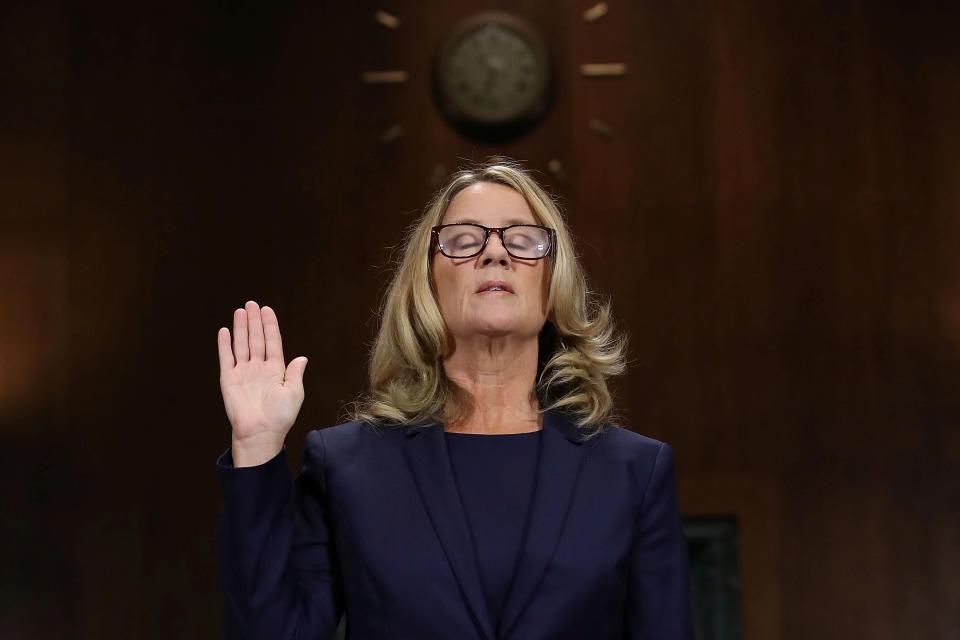
Kavanaugh’s angry and emotional afternoon testimony was shocking, and raised questions about his demeanor and his ability to show impartiality on the court. But it also saved his nomination and rallied the Republican base.
It also rallied Democrats. One poll in mid-October showed that the Kavanaugh hearings had motivated more Democrats to vote than Republicans, by 10 points. But when it came to battle over control of the Senate, it looked like the overall intensification of the electorate had helped the GOP.
Two weeks after the Kavanaugh hearings, FiveThirtyEight.com had moved Republican chances of holding the Senate from just under 70 percent to nearly 80 percent. That’s because in key Senate races in conservative states — North Dakota, Tennessee, Missouri, Indiana and Texas — Democrats lost ground.
FiveThirtyEight’s latest projections on Thursday pegged Democratic chances at around the same place. September was the time during which things moved away from Democrats in the Senate. And while the Kavanaugh hearings haven’t been decisively proven to be determinative, if Republicans maintain control of the Senate, that will be remembered as a moment in which Republican voters in conservative states woke up and rallied to their side.
Many Republican voters believed the initial allegation of sexual assault during Kavanaugh’s high school days was credible and should have been investigated, but that was then followed by more dubious claims of misconduct from other women, which were picked up by Democratic senators, interest groups and publicity chasers. That created a media circus that many conservatives felt amounted to character assassination.
Trump tried to build on conservative anger over the Kavanaugh nomination by rallying his supporters behind fears of immigrants and scorn for the media. But a series of unexploded pipe bombs — sent by a Trump supporter to prominent critics of the president — followed by the murder of 11 people at a Pittsburgh synagogue, drove Trump’s approval rating downward significantly and stepped on his message.
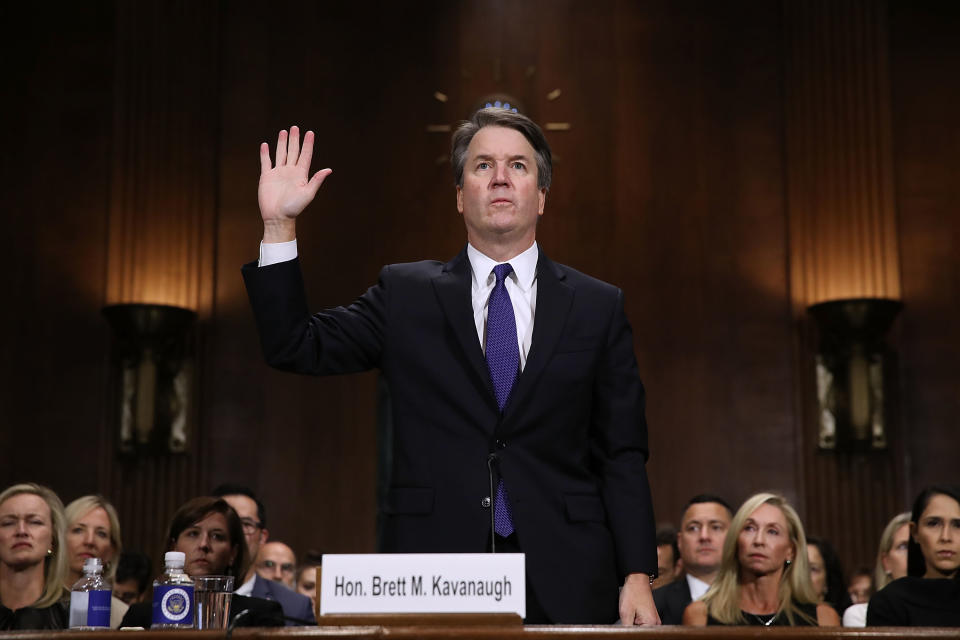
Trump is campaigning during the final week in some of the states where Republicans surged after the Kavanaugh hearings: Missouri, Indiana and Tennessee most noticeably. But not all states fit this pattern. In Florida, Sen. Bill Nelson, a Democratic incumbent, saw his chances of winning rise between early September and early October. But Trump is rallying in that state twice this week, counting on his own personal popularity to help carry Republican Rick Scott over the finish line.
In other states where Democratic fortunes have improved of late, Trump is staying away. Arizona Democrat Kyrsten Sinema got a bounce after the Kavanaugh hearings, and Trump was asked by operatives to stay away from Arizona for fear he would drag down Republican candidate Martha McSally.
– Jon Ward
_____
Read more Yahoo News midterms coverage:
In Texas Senate race, both parties are at the door — all 7.4 million of them
Battle for the soccer-mom vote plays out in suburban Detroit
Menendez race pits ethical concerns against party loyalty, and loyalty is winning
A House rematch sheds light on how landscape changed from 2016
Virginia Republican congressman tries to weather scandal and wave of spending



